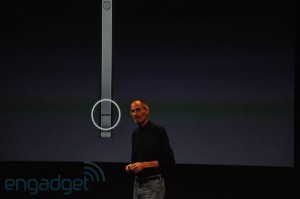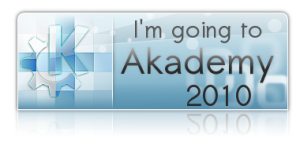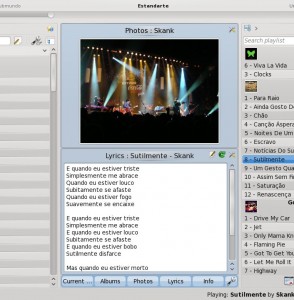Today there was this presentation from Apple to talk about the famous iPhone4 antenna problem. I’ll represent this problem (bug) with the picture below made by one of INdT’s designers (Patricia Montenegro) some time ago:
To be honest I wasn’t expecting anything “technical” in the sense that I wasn’t expecting a technical explanation to the problem itself (you can find it in numerous places on the web) or for a possible solution, but I wanted to watch how Jobs would deal with with the situation.
Being honest again, he did what he does best! At first, he acknowledged the problem as it couldn’t be denied. Then he said that actually they did a favor to the smartphone’s industry because there were other phones with the same problem (showed pictures of other phones having the same issue – what doesn’t prove much, but…) but instead of “hiding” the antenna and hiding the problem, they actually put a big “X” on the problem (see picture below).
From my point of view it was just what we would call a “n00b” mistake :). I mean, Apple is doing phones since not so many time ago. It’s their 4th device (iPhone, iPhone 3G, iPhone 3GS and iPhone4 now), and they just didn’t face this problem before and had the brilliant idea. The problem may show up on other phones? Sure, but I’m sure that the other manufacturers know about the problem and try to “fix” it, being that hiding the antenna inside the case or whatever.
The next steps were just the table’s “turn over” (not sure if this expression exists in English, but it works pretty well in Portuguese :P): some (small) numbers about the how many people were actually affected by the bug. It was less than 1 in a 100 users (a beautiful way of saying less than 1% hehe). They get these numbers from the people that actually complained at Apple Care about the issue so those out there that just reading Engadget and Gizmodo about the issue were not counted of course.
But besides the number being so small, Apple does care about it’s users. All of them. See the kind of words used here? This is the place to do the magic trick. This is the place where you say that you’re not evil or bad but you actually care. Just after stating that you human enough to make mistakes, you ensure your “human position” showing that you care about others. Genious! It’s a statement that just makes the others stronger ;).
In order to take care of those 1% Apple will give for free cases for the iPhones, what prevents the bug and users will even be able to choose colors! And if they do not want the case, then a refund is offered. In Brazil this would be something that they would need to do because of the law: if you sell something that doesn’t work, you need to refund. I’m not sure how this works out on US but anyway, he transformed the user’s “right” into a company’s “feature”. Points again for Apple and Jobs for playing nice with the words.
After that, it was just more slides about all the nice features of iPhone4, why you should have one and more and more statements that Apple loves it’s users (yes, the word love is used in all the slides).
Summary: from the technical point of view it was just “we don’t have a way to fix this as this is a hardware problem and it’s a huge problem then.”. But saying so is the same as pushing the picture of our fellow bug in every user’s face.
Instead of doing that, they will solve the issue by giving the users a rubber case that costs less than 1 dollar and then create a link between the users and the company that is: “we are all humans. have you ever made a mistake? this is our first mistake. sorry. take this gift. ah, by the way we love you.”. This creates compassion (every human did something wrong once in his life) and then people stop bashing the company and it’s product. This “love history” also reinforces that they are humans, enabling them to screw things eventually. So with a few minutes, Jobs got our fellow and dressed him properly transforming The Bug in a Feature:
From my point of view, the truth is that Apple is a company with a product that costs you some money and just like any other company in any other industry, the products should be properly tested and should not have this kind of problems that are not solvable (what if they didn’t have the luck of the case solving the issue?). The good about open source products is that at least from the software side we can fix stuff as quick as possible. So please vendors: pay attention to the hardware you manufacture and leave them as open as possible to software that we want to put into that! 😀




















